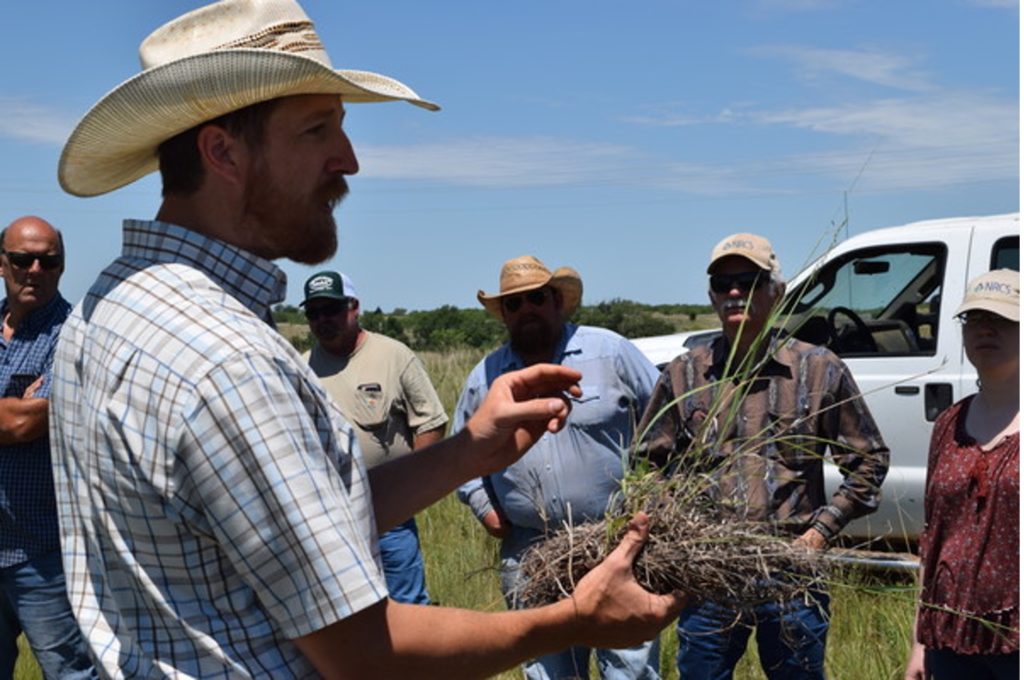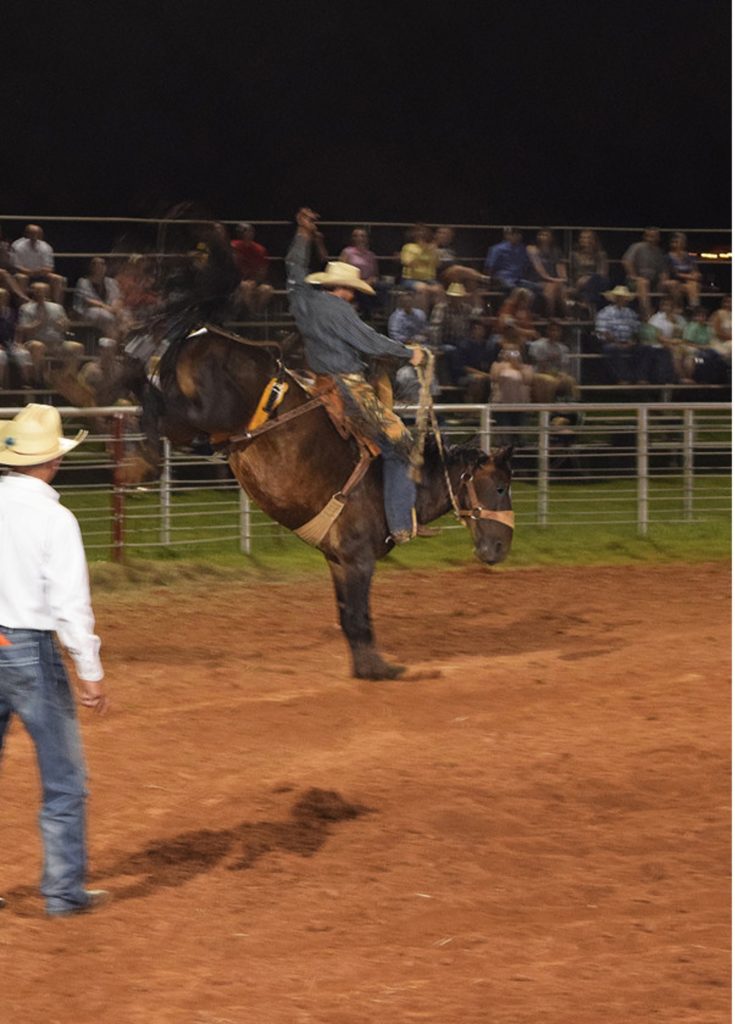Soil health educator excited about rodeo’s “Cowboy Christmas”
Dirt, or rather soil, falls into two interesting measurements of time in Blane Stacy’s life – eight hours and eight seconds.
Rodeo and dirt – or as Stacy calls it, “Soil” – have each come to garner a special place in the 31-year-old’s life.
The full-time soil health educator with the Oklahoma Conservation Commission (OCC) is a part-time saddle bronc rider who has qualified three times for the International Finals Rodeo (IFR).

Born one day after Christmas, Dec. 26, 1987, Stacy craves that Fourth of July run that rodeo diehards refer to as “Cowboy Christmas” where the intent is to collect a lot more checks than dirt in a short amount of time. There are so many rodeos in this span.
Last year, Stacy’s summer holiday got off to a painful start. The 6-feet, 1 inch, 185-pounder with a bristly red mustache took some time off work and entered rodeos for July 3 through July 15. In that stretch Stacy would have only one day he wouldn’t be climbing aboard a bronc. Each time out he’d been looking to make an eight-second qualified ride.
On the first day of that stretch, at Moline, Kan., Stacy dislocated the right shoulder of his riding arm.
It is often said, “There are no disabled lists in rodeo.” There’s a lot of grit though. So the cowboy who lives in Blanchard, Okla., “gutted it out” for the next 12 days, winning six of 11 rodeos.
This year, the gate swung open on the Christmas run last Friday night at the Edmond (Okla.) Liberty Fest International Professional Rodeo Association (IPRA) and Open Rodeo. After winning both stops the previous weekend at Siloam Springs, Ark., and Carthage, Mo., Stacy drew a horse called Webster County of Sumner Rodeo Company at Edmond.
The chute three gate swung open and … stay tuned.
Below the surface
Time has played a lot of roles in Stacy’s life –both in large and small chunks.
Go back to the years of growing up farming and ranching near Delaware, Okla., as the youngest of Kevin and Cathy Stacy’s two children.

“We didn’t call it Conservation or Soil Health, it was simply managing the resources we had — grass, soil, cows — to be profitable, productive, and progressive,” he said. “The knowledge of different types of plants that grow in the ecosystem, and what each one was good for shaped how I viewed the natural world.”
Next, dig down a little to one particular week. It came when Stacy was 15 years old. In the summer of 2003 he went as far west as the Oklahoma state line will allow to a camp called Black Mesa Ecological Academy in Cimarron County.
Stacy said, “For seven days we participated in range, soil, livestock, wildlife, archeological, and geospatial activities that I absolutely loved. The fact that there were careers based on the natural resources I loved to study and be a part of, really solidified where I wanted to focus my career aspirations.”
When he says “be a part of” he’s referring in part to competing in Land and Range Judging contests. That led to both state and national, individual and team honors, including an individual State Champion title for Oklahoma Union High School in 2004 and being a member of the National Champion team in 2005.
After graduating with a bachelor’s of Science in Natural Resource Ecology and Management at Oklahoma State University, Stacy gained various forms of conservation experience in jobs over the next few years before going to work at OCC in Water Quality in 2014. Two years later he moved to the OCC Soil Health program.
Now, the cowboy champions soil health through trainings, workshops and offering technical assistance. Somedays his audience is fifth graders from a science class and other days, ranchers trying to recover from wildfires or floods, or both.
“I want to help them improve the soil, increase diversity, and regenerate the land,” he said. “I try to relate everything I talk about to real life experiences that my audience has. I bring the idea that ‘Soil Health affects everyone’ whether it’s a rancher trying to improve grazing, a stormwater planner trying to reduce flooding risk by improving soils’ water holding capacity or a child having a clean swimming place at the creek. The actual steps will vary, but by trying to relate the audience’s personal experiences with how natural resources can affect their lives is how I promote and teach about Soil Health.”
Time marches on
“Five minutes” — that’s Stacy’s split-second answer to how much thought he gave to riding broncs before deciding to do it.
“I’m serious, five minutes,” he repeated. “Sometimes things in life just jump out and grab you, and that’s it. I worked the summer of 2007 in Pawnee, Okla., for the NRCS (Natural Resources Conservation Service) and with a Range Management Specialist named Joe Vielma. At the time, he also helped the OSU Rodeo Club some. One day we were talking about bull riding or something, and he (Vielma) mentioned that ‘you don’t see as many bronc riders these days.’ To this day, I don’t know why that statement jumped out and grabbed me, but I thought, “I think I’m gonna try me some bronc riding.’”

He bought his first saddle bronc equipment off of eBay and just entered the next closest rodeo.
Stacy figures it took him about five years of $80 eight-seconds or less practice sessions at rodeos to get a little seasoning.
Still, he remembers one of those nights like it was last night.
Stacy was working a summer job in Cordell for the NRCS, and there was a rodeo in Mangum he decided to enter. He was maybe 10 horses into his bronc riding career at this point.
“This little wiry grey horse did everything but stab me with a knife in the chute. He would try to flip, lay down, bite, lean on me,” Stacy said. Well, the bronc took some energy out of himself, and the cowboy realized this and nodded for the gate.
Stacy recalls that a classic matchup it wasn’t, but it was a qualified ride.
“First time I had made the whistle, ever,” he said. “I felt so good I hat fanned him a little before I rolled off. It was 64 championship points and was the only qualified score. I won 400 bucks, and I thought I’d never see a bad day again.”
Stacy has qualified for the American Cowboys Rodeo Association (ACRA) Finals nine times, the IFR of the International Professional Rodeo Association (IPRA) three times and the Professional Rodeo Cowboys Association’s (PRCA) Prairie Circuit Finals once. All-in-all, he’s toted his saddle, bronc rein and chaps to 12 states to compete.
Back to Edmond
After difficulties in the chute at Edmond, the judges awarded Stacy a reride — another opportunity to get his Cowboy Christmas rolling.
He would now be paired with Sumner’s bronc Webster County.
Stacy had seen the horse several times at other rodeos, but had never been matched against him.
As the chute three gate swung open, it was showtime.
Stacy said, the powerful bronc “pretty much just did what he’s supposed to do which is jump and kick as high as he can.”
There was an anxious moment or two, but the soil health educator stayed aboard for eight seconds and 74 points. By the end of the rodeo, that would earn Stacy a third place check in the saddle bronc riding.
“I started real good, but there were about two jumps there I thought I was coming off,” Stacy said. “Sometimes in rodeo we get to evaluate the soil a little closer than we’d like to. I can definitely tell you there are probably some soil compaction issues in that arena now where my body hit, but it was after eight seconds.”
In the crowd that night at Edmond, was Stacy’s wife Judy and 10-month-old son Luke Warren Stacy.
Hitting the rodeo trail on a limited basis is a good fit in Stacy’s list of priorities. It allows him to spend more time with his family and to share the story of conservation in fields, schools, at conferences and farm shows or other venues.
“I’ve found the perfect blend,” he said.
